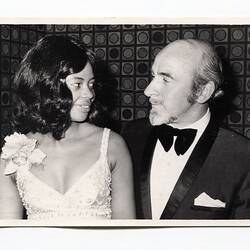Summary
An album of Cole Porter's musical film 'Can Can' starring Frank Sinatra, Shirley MacLaine, Maurice Chevalier and Louis Jourdan. It consists of a vinyl record in its original plastic sleeve within the album cover. It was produced by Capitol Records and released in 1960, the same year as the original film. Lindsay and Sylvia Motherwell both enjoyed a variety of music, from jazz to musicals.
Sylvia Boyes (a South African-born orphan) and Lindsay Motherwell (a Melbourne-born drummer) met in Cape Town, South Africa in 1967 through their theatre connections. They fell in love but due to apartheid laws were forced to leave South Africa to marry in London. They subsequently relocated permanently to Melbourne in 1970.
Physical Description
A 12" record in its original plastic sleeve within a cardboard album cover. The front cover is split into two parts. On the left hand side was an orange box containing the words "Cole Porter's CAN-CAN STARRING FRANK SINATRA . SHIRLEY MACLAINE . MAURICE CHEVALIER AND LOUIS JOURDAN". On the left hand side are three photos from the film, representing all of the principal actors and singers. Across the top are the words "ORIGINAL SOUNDTRACK ALBUM", and across the bottom is a series of credits of the people involved in the film and soundtrack. On the back cover is white, with three black and white photographs from the film. Above that is the title of the film, and other information. Beneath the photos is a short blurb about the film, and a list of the songs on each side of the album. Across the bottom are the copyright details.
Significance
Statement of Historical Significance:
This collection provides a significant opportunity to represent political and personal freedom as a motivation for migrating to Australia within the international context of both apartheid in South Africa and the end of the White Australia policy in Australia. The personal narrative is well documented and the objects provide a material way to follow the lives of both Lindsay and Sylvia, both separately and where they coincide in South Africa and onwards together to Melbourne. While this is ultimately a love story, it plays out through the collection against the backdrop of apartheid South Africa, sixties London and an increasingly multicultural Australia.
More Information
-
Collecting Areas
-
User
-
User
-
Classification
Music & musical instruments, Playback media - analogue, Disc recordings
-
Category
-
Discipline
-
Type of item
-
Object Dimensions
307 mm (Width), 306 mm (Height)
Size of album cover
-
Keywords
South African Immigration, Travel, Musicians, Jazz Bands, Working Life, Apartheid, Racism, Immigration Policies, Music, Records

